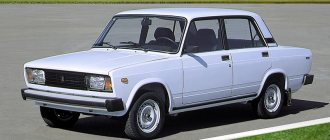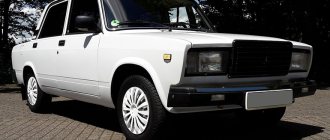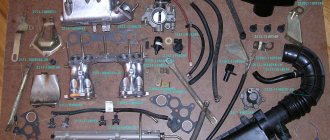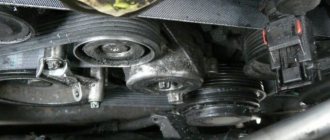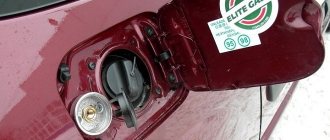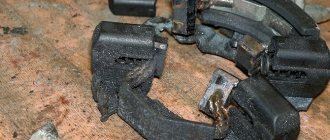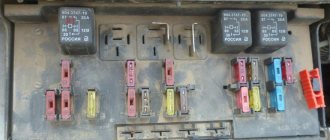VAZ-2107 is one of the representatives of the legendary classic models. It used both types of fuel supply systems. Both injection and carburetor models were produced. Even those copies that were the last to leave the assembly line still work properly. The only weak point of this car is the hardware. For this reason, it is extremely important to know the exact volume of the gas tank of a VAZ-2107 car, because due to corrosion it can give a small leak, which you will be able to notice only when you control the amount of fuel poured in.
Body
| Number of doors | 4 |
| Number of seats | 5 |
| Wheelbase | 2424 mm |
| Front track | 1365 mm |
| Rear track | 1321 mm |
| Ground clearance | 170 mm |
| Maximum trunk volume | 379 l |
| Width | 1620 mm |
| Length | 4145 mm |
| Height | 1440 mm |
This is interesting: In what city is the Nissan Terrano produced?
Technical characteristics of VAZ 2107
The model is a classic rear-wheel drive sedan. There are no front-wheel drive modifications for the VAZ 2107.
The car was only slightly different in size from its predecessor, the “six”:
- length - 4145 mm;
- width - 1620 mm;
- height - 1440 mm.
The curb weight of the “seven” was 1020 kg, the total weight was 1420 kg. As on all VAZ models, the fuel tank volume was 39 liters. For the vast majority of owners, the trunk volume of 325 liters provided the necessary space for transportation.
The latest versions of the “seven” were equipped with a remote control for automatically opening the trunk
Initially, carburetor modifications of power units were installed on VAZ 2107 cars. Depending on the year of manufacture, the engine could operate with either a four-speed gearbox or a five-speed gearbox.
An important feature of the engines on the “seven” is that until 1995 they were equipped with a breaker relay, which can be easily detected when braking with the handbrake.
The braking system was inherited from the “seven” from the “six”: front disc brakes and rear drum brakes.
The ground clearance of all VAZ modifications was not designed for off-road driving, but 175 mm of ground clearance makes it possible to cope perfectly with uneven road surfaces.
In total, over the entire period of production of the VAZ 2107, the car was equipped with five types of engines:
- model 1.5 liter or 1.6 liter, 65 hp, 8 valves, carburetor);
- model 1.3 liter, 63 hp, 8 valves, timing belt);
- model 1.7 liter, 84 hp, 8 valves, mono injection - version for export to Europe);
- model 1.4 liter, 63 hp, version for export to China);
- model 1.7 liter, 84 hp, 8 valves, central injection).
The power unit is located in the front of the machine in the longitudinal direction.
Video: main characteristics of the machine
Repertoire
From the very first years, the basis of the theater's repertoire has been Russian and foreign classics. In addition to popular works, rarely performed works are staged, such as “The Nizhny Novgorod People” by E. Napravnik, “Judith” by A. Serov, “The Huguenots” by D. Meyerbeer, “Fra Diavolo” by D. Aubert, “Lakmé” by L. Delibes, “The Cardinal’s Daughter” » Halevi et al.
All operas by Glinka, Dargomyzhsky, Mussorgsky, operas and ballets by Tchaikovsky were staged.
Among the performances, works by contemporary authors find their place: S. Prokofiev, I. Stravinsky, D. Shostakovich, T. Khrennikov, D. Kabalevsky, A. Crane, M. Chulaki, R. Gliere, J. Gershwin, A. Eshpai, A. Khachaturyan, A. Petrova, A. Rybnikov, F. Amirov.
The repertoire also includes works by Nizhny Novgorod composers, for example, the operas “Stepan Razin” and “Foma Gordeev” by A. Kasyanov; the ballet “Timur and His Team”, the operas “The Cranes Are Flying” and “Modern Pastoral” by A. Nesterov; operetta “Sharp turns” by B. Blagovidov. B. Getselev’s cantata “Keep Me, My Talisman” was performed for the first time on the theater stage.
During its history, the theater, named after A. S. Pushkin, produced 69 performances based on the works of the poet, including the operas: “The Queen of Spades”, “Eugene Onegin”, “Mazeppa” by P. Tchaikovsky, “The Stone Guest”, “Rusalka” A Dargomyzhsky, “Ruslan and Lyudmila” by M. Glinka, “The Golden Cockerel”, “Mozart and Salieri” by N. Rimsky-Korsakov, ballets “The Bakhchisaray Fountain”, “The Bronze Horseman”, “Blizzard” and others.
Since 1986, the All-Russian Pushkin Festival of Opera and Ballet Art “Boldino Autumn” has been held, in which guests both from near and far and, starting from the sixth festival, take part. Starting from the third festival, trips of its participants with concerts to Bolshoye Boldino, the ancient Nizhny Novgorod estate of the Pushkins, became traditional.
Engine
| Engine capacity | 1569 cm3 |
| Power | 75 hp |
| At rpm | 5400 |
| Torque | 116/3000 n*m |
| Gas distribution mechanism | OHC |
| Number of cylinders | 4 |
| Number of valves per cylinder | 2 |
| Cylinder diameter | 79 mm |
| Piston stroke | 80 mm |
| Compression ratio | 8.5 |
Transmission
| Clutch | single-disk, dry, with hydraulic shutdown drive and central diaphragm spring |
| Transmission | mechanical, four- or five-speed, three-way, three-shaft, with synchronizers on all forward gears |
| Gear ratios: | |
| first | 3,67 |
| second | 2,10 |
| third | 1,36 |
| fourth | 1,0 |
| fifth | 0,82 |
| reverse | 3,53 |
| Cardan transmission | two-shaft, with intermediate support and elastic coupling |
| main gear | hypoid |
| Final drive ratio | gear ratio – 3.9 or 4.1 |
| Differential | conical, two-satellite |
Fuel tank capacity Lada - 1982
03.1982 — 04.2012
| Options | Fuel tank volume, l |
| 1.3 MT 21072 Basic | 39 |
| 1.5 MT 2107-20 Basic | 39 |
| 1.5 MT 2107 Basic | 39 |
| 1.6 MT3 Standard | 39 |
| 1.6MT5 | 39 |
| 1.6MT3 | 39 |
| 1.6 MT5 Standard | 39 |
| 1.6 MT2 Standard | 39 |
| 1.6MT2 | 39 |
| 1.6MT3 | 39 |
| 1.6MT1 | 39 |
| 1.6 MT3 Standard | 39 |
| 1.6 MT5 Standard | 39 |
| 1.6MT 21074 | 39 |
| 1.6 MT 21074 Basic | 39 |
| 1.7 MT 2107 Basic | 39 |
| 1.3 MT 21079 Basic | 40 |
This is interesting: How to set the Starline temperature
Performance indicators
| Maximum speed | 150 km/h |
| Acceleration time (0-100 km/h) | 16 s |
| Fuel consumption in the city per 100 km | 9.6 l |
| Fuel consumption on the highway per 100 km | 6.8 l |
| Combined fuel consumption per 100 km | 9.2 l |
| Fuel tank volume | 39 l |
| Vehicle curb weight | 1060 kg |
| Permissible gross weight | 1430 kg |
| Tire size | 175/70 R13 |
Weight of passenger cars in tabular format
We present to your attention a table that shows the weight of the car by brand.
| Value Parameter value in (kg) | |
| 1.6 l., Petrol, Mechanical, 5 speed, rear | |
| Curb weight | 1060 (kg) |
| Permissible gross weight | 1460 (kg) |
| Load capacity | 400 (kg) |
| 1.3 l., Petrol, Mechanical, 4 speed, rear | |
| Curb weight | 1030 (kg) |
| Permissible gross weight | 1430 (kg) |
| 1.3 l., Petrol, Mechanical, 5 speed, rear | |
| Curb weight | 1040 (kg) |
| Permissible gross weight | 1430 (kg) |
| 1.6 l., Petrol, Mechanical, 5 speed, rear | |
| Curb weight | 1030 (kg) |
| Permissible gross weight | 1430 (kg) |
| 1.7 l., Petrol, Mechanical, 5 speed, rear | |
| Curb weight | 1030 (kg) |
| Permissible gross weight | 1430 (kg) |
| car model | Curb weight |
| Weight of the Oka 1111 car, weight of the Okushka | 635 kg |
| Weight of the car Oka 1113 | 645 kg |
| Weight of a VAZ 2101 car, weight of a penny | 955 kg |
| Weight of the VAZ 2102 car | 1010 kg |
| Weight of the VAZ 2103 car | 965 kg |
| Weight of the car VAZ 2104, weight of tens 2110 | 1020 kg |
| The weight of the VAZ 2105 car, the weight of the five | 1060 kg |
| Weight of the VAZ 2106 car, weight of the six | 1045 kg |
| Weight of the VAZ 2107 car, weight of the seven | 1049 kg |
| Weight of the VAZ 2108 car | 945 kg |
| Weight of the VAZ 2109 car, weight of the nine | 915 kg |
| Weight of the VAZ 2111 car | 1055 kg |
| Weight of a VAZ 2112 car, weight of a twelve-wheeler | 1040 kg |
| Weight of the VAZ 2113 car | 975 kg |
| Weight of the VAZ 2114 car, weight of the four | 985 kg |
| Weight of the VAZ 2115 car, weight of the tag | 1000 kg |
| Weight of the VAZ 2116 car | 1276 kg |
| Weight of the VAZ 2117 car | 1080 kg |
| Weight of the Niva 2121 car | 1150 kg |
| How much does a Chevrolet Cruze weigh (Chevrolet Cruze weight) | 1285-1315 kg |
| How much does a Chevrolet Niva weigh (Chevrolet Niva weight) | 1410 kg |
| How much does a GAZ (Volga) weigh, the weight of a Volga is 24 | 1420 kg |
| How much does GAZ 2402, GAZ 2403, GAZ 2404 weigh? | 1550 kg |
| How much does GAZ 2407 weigh? | 1560 kg |
| Car weight Moskvich 314 | 1045 kg |
| Weight Moskvich 2140 | 1080 kg |
| Weight Moskvich 2141 | 1055 kg |
| Car weight Moskvich 2335, 407, 408 | 990 kg |
| How much does a UAZ 3962, UAZ 452 weigh, how much does a UAZ loaf weigh? | 1825 kg |
| How much does UAZ 469 weigh? | 1650 kg |
| How much does UAZ Patriot weigh? | 2070 kg |
| How much does UAZ Hunter weigh? | 1815 kg |
| How much does Nissan weigh (weight of nissan x-trail car) | 1410-1690 kg |
| How much does Qashqai weigh (weight of Nissan Qashqai car) | 1297-1568 kg |
| How much does a Nissan Juke weigh (Nissan Beetle weight) | 1162 kg |
| Ford Focus car weight (how much does a Ford Focus weigh) | 965-1007 kg |
| Weight of the Ford Focus 2 car (how much does the Ford Focus 2 weigh) | 1345 kg |
| Weight of the Ford Focus 3 car (how much does the Ford Focus 3 weigh) | 1461-1484 kg |
| Ford Kuga car weight (how much does a Ford Kuga weigh) | 1608-1655 kg |
| Weight of the Ford Escort (how much does the Ford Escort weigh) | 890-965 kg |
| Weight of the Renault Logan car (how much does the Renault Logan weigh) | 957-1165 kg |
| Renault Duster car weight (how much does a Renault Duster weigh) | 1340-1450 kg |
| Renault Sandero car weight (how much does a Renault Sandero weigh) | 941 kg |
| Weight of the Opel Mokka car (how much does the Opel Mokka weigh) | 1329-1484 kg |
| Weight of the Opel Astra car (how much does the Opel Astra weigh) | 950-1105 kg |
| Mazda 3 car weight (how much does mazda 3 weigh) | 1245-1306 kg |
| Weight of the Mazda CX-5 (how much does the Mazda CX-5 weigh) | 2035 kg |
| Mazda 6 car weight (how much does mazda 6 weigh) | 1245-1565 kg |
| Volkswagen car weight (how much does a Volkswagen Tuareg weigh) | 2165-2577 kg |
| Weight of a Volkswagen Polo car (how much does a Volkswagen Polo weigh) | 1173 kg |
| Weight of the Volkswagen Passat car (how much does the Volkswagen Passat weigh) | 1260-1747 kg |
| How much does a Toyota Camry weigh (weight of a Toyota Camry) | 1312-1610 kg |
| How much does Toyota Corolla weigh (weight of Toyota Corolla) | 1215-1435 kg |
| How much does a Toyota Celica weigh (Toyota Celica weight) | 1000-1468 kg |
| How much does a Toyota Land Cruiser weigh (Land Cruiser weight) | 1896-2715 kg |
| How much does the Skoda Octavia weigh (weight of Skoda Octavia) | 1210-1430 kg |
| How much does the Skoda Fabia weigh (Skoda Fabia weight) | 1015-1220 kg |
| How much does the Skoda Yeti weigh (Skoda Yeti weight) | 1505-1520 kg |
| How much does a Kia Sportage weigh (KIA Sportage weight) | 1418-1670 kg |
| How much does Kia Sid weigh (weight of KIA Ceed) | 1163-1385 kg |
| How much does the Kia Picanto weigh (KIA Picanto weight) | 829-984 kg |
Thus, it turns out that if we take, so to speak, “in general for the hospital,” then the average weight of a passenger car is approximately from 1 to 1.5 tons, and if we talk about SUVs, then the whole weight already shifts from 1.7 tons to 2. 5 tons.
weight of a passenger car, how much does OKA weigh, how much does a car weigh, weight of a car, how much does a Matiz weigh, how much does a Matiz weigh, weight of a Skoda car, weight of an Audi
Other
VAZ 2107 21074 1.6 MT is a 4-door car with a 5-speed gearbox. With the number of seats for the driver and passengers: 5. The maximum possible speed is 150 km/h. The car accelerates to 100 km/h in 16 seconds. Average fuel consumption per 100 km is: in the urban cycle - 9.6 liters, on the highway - 6.8 liters, in the combined cycle - 9.2 liters. Maximum fuel tank volume is 39 l. A full tank is enough for approximately: 406 km when driving around the city, 574 km when driving on the highway, 424 km when driving the combined cycle. The maximum carrying capacity of the vehicle is 370 kg.
- Fuel consumption VAZ 2107
- Maximum speed of VAZ 2107
- Dimensions and dimensions of the VAZ 2107
- Acceleration to 100 km/h VAZ 2107
Transmission
| Clutch | single-disk, dry, with hydraulic shutdown drive and central diaphragm spring |
| Transmission | mechanical, four- or five-speed, three-way, three-shaft, with synchronizers on all forward gears |
| Gear ratios: | |
| first | 3,67 |
| second | 2,10 |
| third | 1,36 |
| fourth | 1,0 |
| fifth | 0,82 |
| reverse | 3,53 |
| Cardan transmission | two-shaft, with intermediate support and elastic coupling |
| main gear | hypoid |
| Final drive ratio | gear ratio – 3.9 or 4.1 |
| Differential | conical, two-satellite |
Tuning VAZ → there is not enough gasoline in the tank. what to do?
about 25 liters of gasoline enters, after which the gun turns off (gasoline is visible in the neck). the sensor shows a full tank - it’s lying to me)) tell me what’s wrong? car 2107 injector
- Senya_Sid
- 10 January 2016, 15:45
- Maxim_Potapov
- January 10, 2016, 15:50
- v
- Stanny_Eliseev
- 10 January 2016, 15:51
- v
- Igor_Grigorev
- 11 January 2016, 04:56
- v
- Stanny_Eliseev
- 11 January 2016, 07:46
- v
- Gorik_Kurochkin
- 11 January 2016, 08:48
- v
- Maxim_Smirnov
- 11 January 2016, 16:26
- v
- Maxim_Potapov
- 11 January 2016, 16:28
- v
- Senya_Sid
- 11 January 2016, 16:29
- v
- Senya_Sid
- 11 January 2016, 16:37
- v
- Maxim_Potapov
- 11 January 2016, 17:23
- v
- Sergey_Shevelev
- 11 January 2016, 17:38
- v
- Vengr_Koryakov
- 11 January 2016, 17:56
- v
- Stanny_Eliseev
- 11 January 2016, 20:53
- v
- Vengr_Koryakov
- January 12, 2016, 07:03
- v
- Stanny_Eliseev
- January 12, 2016, 07:29
- v
- Vengr_Koryakov
- January 12, 2016, 07:34
- v
- Stanny_Eliseev
- January 12, 2016, 10:47
- v
- Vengr_Koryakov
- 12 January 2016, 18:35
- v
because my father always had 4-6 liters left on the carb when it caught fire, and I have 10-12 liters left, that’s the difference; it was done so that the pump would not overheat
Replacement of gas tank and major repairs
Regardless of what type of fuel injection is used on your vehicle, the process for removing the tank will be the same. First drain all fuel from it. Next, carry out the following work:
- Remove the plastic casing from the container. To do this, you will need to unscrew several screws using a Phillips screwdriver.
- Disconnect the wires from the contacts leading to the fuel sensor.
- Use pliers to pry off the fuel hose.
- Unscrew the bolt of the tension plate that secures the gas tank.
- Remove the cap from the neck and carefully remove the tank.
Assess its condition. If there are several leaks or they are too large, then it will be easier to replace the entire fuel container. To do this, simply take a new tank and reassemble it in the reverse order.
If you do not have the opportunity to buy a new container, then stock up on:
- fiberglass;
- epoxy resin;
- acetone;
- sanding paper.
First, dry the tank thoroughly; if you start repairs immediately after dismantling, you will be disappointed with the result. Next, proceed to repair work:
- Cut the fiberglass into pieces so that they completely cover the leaks or holes.
- Impregnate the material with epoxy resin.
- Lay the fiberglass cloth over the leak area and level it so that there are no bubbles on the surface. Remove excess resin. The first layer is the most important, so take your time.
- Dry the patches, then putty them and paint them with primer.
Such repairs may last for varying periods of time from 3 months to 3 years. It all depends on the climate and the degree of neglect of corrosion processes. It is more effective to immediately change the tank, then you won’t have to worry that the patch will let you down. The cost of a new spare part is about 3 thousand rubles.
How to detect a leaking gas tank
There is no need to worry about noticing a leaking gas tank. If gasoline escapes from the fuel tank, this will be accompanied by the following symptoms:
- Significant increase in fuel consumption. It’s hard not to notice that gas is running out, even if the car is parked.
- There will be a distinct smell of gasoline inside the car.
- Rainbow spots will remain on the asphalt where your VAZ 2107 was parked.
If at least one of the above signs occurs, most likely, your VAZ 2107 with an injector system actually has a leak in the gas tank. There are several options for action in this situation; we will divide them into emergency and planned.
Emergency gas tank repair
If your car’s gas tank leaks on the highway and you can’t get to the nearest car service center without repairs, you can use a few tricks that will help temporarily return the fuel tank to operation.
The simplest and most effective way: seal the gas tank with rubber or plastic. For this we need:
- Superglue or ordinary glue moment.
- A piece of rubber from a tire or a plastic bottle.
So, the first thing you need to do is find the place where the gas tank is damaged, where fuel is escaping. In the case of the VAZ 2107, the injector system is leaking most likely from below; its cause is a hole or corrosion damage. As soon as the damage is detected, we proceed as follows: cut out a piece of rubber or plastic, lubricate it with glue and press firmly against the damage. After a few minutes you can release the patch, it will finally set in a couple of hours, but in any case you can go. You can easily get to a car service center with such a patch; there are cases when car enthusiasts drove with it for several weeks.
Fuel tank VAZ 2107
Another way to seal a hole is with a regular self-tapping screw. Suitable if the damage is small in diameter and you have a rubber seal for the screw. This is done as follows:
- First you need to find the location of the damage.
- Then install the seal on it (a regular piece of a car inner tube will do).
- Screw a self-tapping screw into the seal so that it fits into the gap in the gas tank and plugs it.
Repair with improvised means
If you are away from a garage or home where you have the necessary tools to remove the tank, you can carry out emergency repair work. For this you will need to have on hand; “Moment” glue or any other composition for rubber or plastic; a piece of tire, thin rubber or plastic bottle.
Look for a leak on the fuel tank; most often it is located at the bottom, since the tank is corroded by moisture or holes. Glue the patch to this place, hold it for a few minutes and leave for 2-3 hours until the composition has completely set. After such repairs, you will easily get to the nearest service station. There have been cases where motorists used a tank patched on the road for up to several weeks, but you should hurry up with major repairs, as sometimes patches do not help.
For the second emergency repair option, you will need to have a self-tapping screw on hand. If the diameter of the hole in the tank is small, then it is advisable to screw a simple self-tapping screw into it with a rubber or neoprene washer put on it. You can make your own washer from a piece of rubber bladder. In this case, screw the screw directly through the small rubber flap.
Remember that any of the described repair methods is a temporary measure. Stop at the nearest car service center so as not to encounter a more global problem while traveling or away from populated areas if you often go on intercity trips.
If you notice a leak and decide to fix it with your own hands, the first thing you need to do is dismantle the VAZ 2107 gas tank; the process is similar for both the carburetor and a car with an injector system.
All about model refueling fluids
As mentioned above, the VAZ 2107, like all models of the manufacturer, is equipped with a 39-liter gas tank. This volume is quite enough for long continuous trips. Of course, in recent years, due to a sharp increase in fuel prices, the tank volume has become enough for only 3-4 hours of driving on the highway.
Fuel
Initially, the “seven” was refueled exclusively with A-92 gasoline. However, some of the latest versions of the model implied the use of diesel fuel (VAZ 2107 - diesel). However, diesel modifications of the VAZ 2107 did not gain popularity in Russia due to the high cost of the car and increased fuel consumption.
AI-92 fuel is the main filling fluid for the engine
Engine oil
Another filling fluid for the car is the oil in the power unit. AvtoVAZ engineers recommend that drivers fill the engine with lubricant that meets the minimum requirements of API SG/CD standards . This marking is usually indicated on containers with consumable liquid.
For VAZ 2107 engines, according to the SAE classification, the following oils are recommended:
- Lukoil Lux - 5W40, 10W40, 15W40.
- Lukoil Super - 5W30, 5W40, 10W40, 15W40.
- Novoil-Sint - 5W30.
- Omskoil Lux - 5W30, 5W40, 10W30, 10W40, 15W40, 20W40.
- Norsi Extra - 5W30, 10W30, 5W40, 10W40, 15W40.
- Esso Ultra - 10W40.
- Esso Uniflo - 10W40, 15W40.
- Shell Helix Super - 10W40.
Where oil is present, experts recommend changing the oil filter as well.
Transmission oil
It is also necessary to maintain an optimal level of lubrication in the gearbox - transmission. For VAZ 2107 with 4 and 5-speed gearboxes, the same types of transmission oils are used.
AvtoVAZ engineers draw the attention of owners that only special gear oil of groups GL-4 or GL-5 should be poured into the gearbox. The viscosity grade must be designated SAE75W90, SAE75W85 or SAE80W85.
It is important not to overdo it with pouring lubricant into the transmission: no more than 1.35 liters of oil can be poured into a four-speed gearbox, and 1.6 liters of oil into a five-speed gearbox.
When changing transmission oil, it is necessary to fill in a clearly defined amount of fluid.
Coolant
The VAZ 2107 power unit needs high-quality cooling. Therefore, all versions of the “Seven” have a liquid cooling system. It is based on antifreeze. In the 1980s, the use of antifreeze was not practiced in the USSR, so engineers used only antifreeze to cool the engine .
In recent years, car enthusiasts have been pouring both antifreeze and antifreeze into the expansion tank without any consequences for the operation of the car. In some cases, during the summer months it is even possible to use ordinary water as a coolant, but the manufacturer does not recommend adding water.
Operating a car without coolant can lead to overheating and engine damage.
How long will gasoline last if the light comes on? Also, why can’t you empty the tank?
The VAZ-2107 stove does not heat (carburetor, injector): reasons, repairs
Often it is the girls who ask me seemingly elementary questions, but they are important to them. One of these is how many kilometers will gasoline last if the light comes on. To be honest, I wanted to present this information for a long time, but from a slightly different side, namely, why shouldn’t you empty the car’s tank, that is, drive until it’s almost dry! In general, we read a lot of useful information...
To begin with, I would like to say that tanks have changed, they have evolved along with cars, and the point here is not in the metal tank itself (although they now have plastic ones), it’s all in its filling, namely in the method of supplying fuel.
How fuel is supplied
If we recall the recent past, namely carburetor engines, the tank often served as just a container for gasoline into which a tube was installed for pumping fuel into the system - it went to the very bottom, which made it possible to pump out fuel to the maximum. But the pumping was carried out using a special mechanical fuel pump; it had no electrical parts at all, and it received energy from the mechanical operation of the engine
The most important thing is that the fuel pump was located on the engine, remember this!
Much water has passed under the bridge since those times; now the design has changed dramatically.
Injectors and electronic fuel supply and ignition systems have become an integral part of our lives. Nowadays there is no longer a mechanical fuel pump - it is electric and is located in the tank, and not on the engine.
If you look at this solution, then they killed two birds with one stone - firstly, there are no long lines to the pump, and secondly, they removed the overheating of the electric motor by immersing it in gasoline - after all, it gets seriously hot during operation. Afterwards, it supplies fuel to the line, and only later to the fuel rail.
What does this icon mean and why is it lit?
The icon is made in the form of a gas station, so that it is clear that you need to go there. And it lights up red, or yellow, maybe even orange - because it signals danger, namely due to low fuel level. After a certain mileage you will simply stop, so it’s urgent to “fill up” the tank.
It should be noted that in modern cars, this seems to have a double meaning, not only about low fuel levels, but also about possible breakdowns, more on that below.
About the light bulb and tolerances
Many manufacturers indicate the fuel level in the operating instructions for the car, others in the specifications on websites or dealer networks. To be honest, there is simply no single norm! It all depends on the shape of the tank and its design, but there is an unspoken standard:
Usually there is about 5 - 7 liters of fuel left, and this is enough for about 50 - 60 kilometers. It all depends on the engine size and your driving style. I would also like to note that the more you allow your car to idle, the less mileage it will have. I think this is logical.
To be honest, I measured it on my car once (I simply don’t advise you to do more, you’ll understand why later) - I have about 60 kilometers. It is also worth noting that, purely structurally, there are, as it were, two divisions on the AVEO.
The first is when “LOW” is written, one stick on the tank scale lights up, then it will last for about 70 km.
The second is when the “lamp” also lights up - then it remains for 50 kilometers.
By the way, on many cars, the inscription may light up, and not the gas station icon.
Why shouldn't you let the tank empty?
The fuel level drops, the pump tries hard to pump in the remains, its body is completely exposed and begins to heat up. This has a very negative effect on it; if you like, such overheating can cause its failure.
Remember a simple truth - do not reach a dry tank! This negatively affects the fuel pump. As soon as the light comes on, you need to immediately go to the gas station and fill up with fuel.
In a good way, make it a rule not to even reach the lamp; as soon as the fuel level has dropped, but the lamp is not yet on, we go to the gas station. Thus, the pump will always be in gasoline and cool properly.
Now we are watching a short video.
Didn't find the information you are looking for? on our forum.
We recommend reading:
Storage of motor oil, expiration dates, regulations
Totachi engine oil 10w40
Shell hx8 5w40 engine oil reviews, specifications
Idumitsu engine oil 5w30, characteristics
Motor oil zic x9 ls diesel. Description, where used, characteristics
Black smoke from the exhaust pipe, gasoline or carburetor
Checking gasoline for octane number, how and with what they check fuel
How to clean your windshield from grease stains
Description of the salon
Having first appeared in 1982, the VAZ 2107 did not differ from its predecessors and competitors in any modern devices or design. However, even those little things that the manufacturer decided to introduce into the new Lada model played into the hands: the car became more convenient and attractive for drivers.
Interior trim
The interior trim was fully consistent with Soviet ideas about fashion. For example, higher quality plastic and wear-resistant fabrics were used. For the first time, the seats acquired an anatomical shape and received comfortable headrests. In general, the VAZ 2107 was the first in the manufacturer’s line to receive the title of a comfortable car for people.
Hard plastics and wear-resistant fabrics are used for interior upholstery.
Dashboard
However, if the interior, at the very least, stood out from similar AvtoVAZ models, the instrument panel was always made in strict accordance with existing standards. We can say that the dashboard is featureless, although it houses the tachometer and additional services of instruments and sensors.
On the panel there are only important devices, without decorations or frills.
This is probably why almost all VAZ 2107 owners try to somehow personalize the instrument panel in their cars. Some hang icons, others - flavors, others - toys... After all, a dull instrument panel affects the mood, so depending on capabilities and taste, drivers often resort to tuning this area of the car.
Gear shift diagram
The gearbox on the VAZ 2107 is needed to transmit torque from the engine to the transmission.
The gear shift pattern on a five-speed gearbox is not much different from a four-speed one: the only difference is that another speed has been added, which is activated by pressing the lever all the way to the left and forward.
The gear shift pattern on a five-speed gearbox is not much different from a four-speed one.
All 7 gearboxes also have reverse gear. The transmission itself is necessarily sewn into the housing with a lever located on it to change gears.


